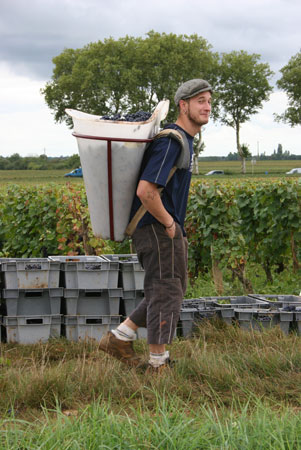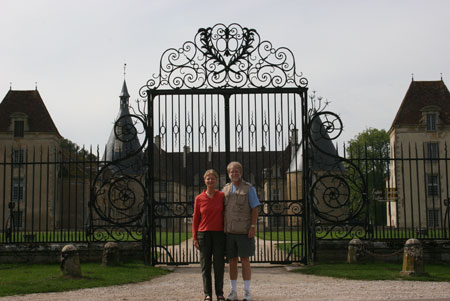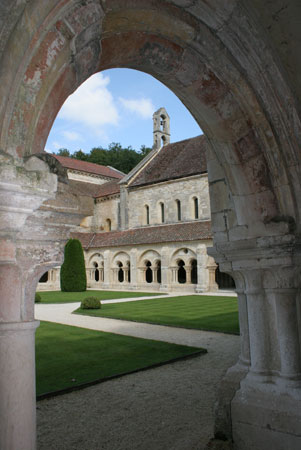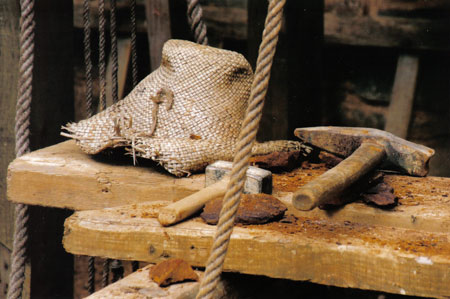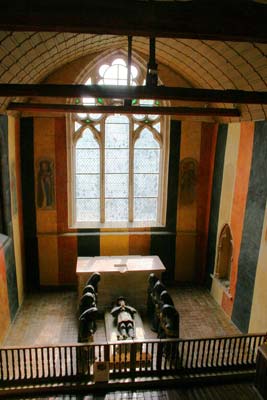Burgundy — oh, so much more than wine
by Paula Prindle, Orient, OH
I love wine, and my husband, David, and I really enjoy traveling to France during la vendange, the grape harvest, so far be it from me to denigrate Burgundy’s largest export and claim to fame. But “La Bourgogne” has so much more to offer visitors than just wine.
Burgundy’s pace is more leisurely than that of Paris, the Riviera and other congested areas of France, but so is the pace of many of France’s rural provinces. What sets Burgundy apart is the sheer voluptuousness, the incredible joie de vivre that is La Bourgogne. It offers a combination of low stress; mild climate; pastoral scenes of sheep and Charollais cattle; Gallo-Roman ruins; medieval castles and towns encased in ramparts (not tourists); Romanesque and Gothic churches and abbeys; fine wines, of course, and fabulous food.
The cuisine
For a real “taste” of France, you must head to Burgundy — la cuisine bourguignonne rivals any of the world’s finest cuisines. After all, who has not heard of boeuf bourguignon or coq au vin? But did you know that escargots, Dijon mustard and kir, the ubiquitous before-dinner drink, all come from Burgundy? And there’s more!
There are two ways to really savor the pleasures of Burgundian cuisine. The obvious way is to dine exclusively in the pricey but well-worth-it upscale restaurants that dot the province. The other way is to stay in a bed-and-breakfast that offers dinner. We obviously chose the second option.
All of the dinners we have had in French chambres d’hôtes have been excellent (see April ’06, pg. 60), but the ones we had in Burgundy were outstanding.
A fine choice
Perhaps it makes no difference which B&B you choose in Burgundy, for Burgundians, to a man, are proud of their superior cuisine and take pains to serve only the very best. However, we feel that we really lucked out with our choice, located in the town of Colombier. Surely, no one else (with the exception of my French mother) could have delighted our palates more than Mme Brocard.
Mme Brocard serves dinner every night but Sunday. We didn’t plan to have dinner there every night, but we did. After our first meal we were goners. The entire meal (€19, or $25, per person) was accompanied by bottomless glasses of Burgundy wine. (M. Brocard’s job was to smile constantly and keep glasses filled.)
We were a little surprised that we enjoyed the meal so much. The table was set for 14 and we thought we’d be quite overlooked, since the others were mostly a group of Belgians who had been at the B&B for several days. Not so! We were included in every conversation. Each meal at Mme Brocard’s was a rare treat.
The B&B, separate from the Brocards’ home, has five bedrooms that are quite comfortable and vary from a small double with a shower to two triples with baths. We had the double (€45, or $58, per night). All five rooms have complete facilities en suite. The B&B also has two lounges and a complete kitchen.
In addition, Mme Brocard has three lovely yet affordable gîtes, but meals are generally not available when the B&B is full. The gîtes are varied — a 2-bedroom/1-bath, a 3-bedroom/3-bath and a 4-bedroom/2-bath — and all are very nice.
The 4-bedroom gîte (all large rooms) has a spacious kitchen, a garage and two patios — perfect for a family reunion. This gîte rents for €365-€530 ($480-$696) per week, depending on the season. The smallest one rents for €215-€320 ($282-$420) per week. They can also be rented for shorter periods.
When we first arrived, our home away from home seemed really lost out in the boonies. (Colombier has maybe 12 houses and no shops.) We quickly discovered, however, that it was convenient to all of the places we wanted to visit. The “best of Burgundy” was within easy driving distance.
More information on Mme Brocard’s B&B can be found on the Gîtes de France website (www. gitesdefrance.fr) or by contacting Yvette Brocard (21360 Colombier, France; phone/fax 03 80 33 03 41).
If you do not speak a little French, you may not be happy here. The Brocards try very hard but do not speak English.
Service with a smile
Just as Burgundy is more than wine, it is also more than great food. We planned a 6-night stay here because there is so much to see and do in the area.
Our first full day was a Sunday, so we were off to church. We enjoy worshiping with the locals wherever we go on vacation. Attending a local church is a great way to immerse oneself in the daily life of the inhabitants.
We have attended services in many countries, and we always feel welcome. It doesn’t matter if you understand the service or not; most church services are pretty straightforward and easy to follow. (Hint: you stand when they stand.)
It was starting to rain, the parking was nonexistent and we were late, but we slid into an old wooden pew and admired our surroundings as the Mass continued. This particular church, St. Laurent in Arnay-le-Duc, was established in 1092. Imagine! That was 400 years before Columbus discovered America. (I’m pretty sure our pew was hewn about the same time.)
On to Autun
After the service, we didn’t dally outside the church. The weather and our itinerary both encouraged us onward toward Autun. Autun is one of those hidden treasures of Burgundy. It has many interesting sites yet is quite off the beaten path.
I have a soft place in my heart for Autun because I spent most of a year there in the late ’60s as an exchange student. It had changed a lot in 40 years, but the center of town was still a jewel.
Autun was called Augustodonum by the Romans (named for Caesar Augustus). It was also referred to as “the other Rome,” and several Roman and pre-Roman vestiges remain. This “second city of Gaul” (after Lyon) is home to the largest Roman theater in the country, two well-preserved Roman city gates and a 2,000-year-old tower called the Temple de Janus.
Much of the city’s ramparts still remain, and the Romanesque Cathédrale de St. Lazare dominates the high medieval town center. It houses the relics of St. Lazarus, who rose from the dead.
Be sure to climb up to the Salle Capitulaire (free) where the most famous capitals are displayed. “La Fuite en Egypte,” with Mary and baby Jesus on a donkey led by Joseph, is one of my favorites.
Near the Roman theater is the military school with its wonderfully tiled Burgundian roof à la Hôtel-Dieu des Hospices de Beaune. The high school, on the main square, is called the Lycée Bonaparte. Three brothers, Joseph, Napoléon and Lucien Bonaparte, attended classes there — and so did I! Spend a day in Autun; you’ll be glad you did.
A few tour suggestions
We began the following day by visiting a marvelous little château called La Rochepot. We started out on our own, visiting the grounds and a tower with three ornate bedrooms, then a guide took over for a half-hour tour of the chapel and the main rooms in the château (€6). Take your photos in the tower; no photos are permitted on the guided tour.
We arrived at 11 o’clock and they closed for lunch at noon, on the dot. Needless to say, we felt rushed (no time to buy postcards). Schedule more than one hour for this fascinating, privately owned château.
We did come to Burgundy for the harvest, so it was time to head for the vineyards. We started up the Route des Vins in Puligny-Montrachet and headed north, all the way to the Clos de Vougeot, then stopped for lunch (and a glass of white wine) in Meursault.
In Pommard we tasted some reds and bought an inexpensive (€6.40) bottle with the Pommard label. We learned that all red wines produced in Burgundy are pinot noirs and all whites are chardonnays, except for those around the town of Chablis, of course.
After driving through Beaune, which we had visited three years before, we hit the Route des Grands Crus, passing through Aloxe-Corton, Nuits-St.-Georges and Vosne-Romanée and continuing to the Clos de Vougeot, run since 1944 by that elite company of wine lovers, the Confrérie des Chevaliers du Tastevin.
Here, you can take a guided or a self-guided tour (€3.60). The 13th-century grape presses and cellars made for an interesting visit, and the large, brass “No tipping” sign in three languages was certainly uncommon.
Wine “ceremonies” are held several times a year in the cellars; the three days of wine celebration in November are called Les Trois Glorieuses (The Three Glorious Ones), and I’ll bet they are!
Going medieval
Enough of worldly pleasures! Let’s delve into some history. In Burgundy, you can turn the clock back 800 years and watch a 13th-century château being built. The active worksite, called Château de Guédelon (Treigny; www.guedelon.com), was about two hours’ drive from our B&B. We thought it would definitely be worth it to relive a part of medieval France.
In 1996, a “mad” Frenchman, Michel Guyot, set out to build a castle using only tools and skills from the 13th century. A year later, work started on the Château de Guédelon, and it was about one-third finished at the time of our visit. The projected date of completion is 2023.
Masons, stone--cutters, black----smiths, rope-makers, weavers and potters dressed in medieval garb explain to schoolchildren (and older folk) how they are contributing to the castle’s construction. It is all very authentic, except for the safety glasses and cigarettes. Budget a good hour to visit all the craftsmen (€9). They break for lunch from 1 to 2.
Halfway between Guédelon and our pied-à-terre is Vézelay. We decided to visit the village and its basilica while still in the “medieval mode.”
Vézelay’s Basilique Ste-Madeleine was one of the Christian world’s most important pilgrimage sites, once a notable stop on the route to Santiago de Compostela. But it was also a destination in itself, housing the relics of the very-much-in-the-news Mary Magdalene (the relics were destroyed by the Huguenots in the 16th century). The relics there today are in dispute but are still visible in the crypt.
The Romanesque basilica’s nave, with its light and dark arch stones, is indeed impressive. We followed the directions on street signs and parked at the bottom of the hill, passing three more small parking lots on our way up to the basilica.
In Montbard, the Abbaye de Fontenay surpassed our expectations. To quote my journal, we were “blown away by its beauty.” Rick Steves calls it “perhaps the best picture of medieval abbey life in France.” All I know is we took 49 photos; that tells me something.
We picnicked by the duck pond next to the parking lot, then entered “our” abbey. Only one other couple was there during most of our visit.
Fontenay was founded in 1118 by St. Bernard in reaction to the excesses of many Benedictine abbeys. Soft Gregorian chants played in the abbey church, the streams and fountains providing the only other sound. I’m not sure about poverty, but the other Cistercian tenets of simplicity and solitude are easily discovered at Fontenay (entry, €8.90).
Don’t-miss sites
We bypassed the village of Alise-Ste.-Reine and its ruins of Gallo-Roman Alésia, where Vercingétorix’s Gauls fell to Julius Caesar in 52 B.C., as we had visited it before. It is a worthwhile visit, but once is enough.
We did stop again in Flavigny, however. This tiny hilltop village is where “Chocolat” was filmed, but, more importantly for me, it is where my grandfather was stationed for several months in 1918. Most people know Flavigny for its anise-flavored hard candies (the factory is open for tours in the morning).
This quiet, pedestrian-only town is deserving of a stroll. We passed one couple four times, but few others were about.
Close to “home” were two châteaux that we think everyone should visit: Châteauneuf-en-Auxois and Château de Commarin. They are easily visited in one lazy, get-ready-to-drive-to-Paris-tomorrow day. The two castles are very different and give a good idea of the diversity of French châteaux in general.
Rick Steves is our guru, but we think he made a giant faux pas in his review of Châteauneuf-en-Auxois. He advised us to skip the castle’s interior, but it was the only château we have ever visited where we recall being free to photograph “whatever.” We had a heyday!
They close exactly at noon, so plan to arrive no later than 11:30. The English handout is helpful. Our footsteps on the tile and parquet floors echoed through the beautifully decorated, silent rooms. Don’t skip this medieval castle. We felt so free to look around that it was like we lived there (entry, €5).
Châteauneuf-en-Auxois is visible from a distance. It occupies a strategic position on top of a hill surrounded by rolling countryside and the Canal de Bourgogne.
Take a few minutes to drive, walk or bike along this canal. It is very picturesque and often shrouded in fog in the morning.
Arriving at the Château de Commarin during the de rigueur lunch break, we were delighted to spot a bench across the road beckoning us and our picnic lunch. We were even more delighted to discover that Commarin’s lone boulangerie was still open at
1:00! In a country where 12 to 2 is sacrosanct, this was indeed a find. We enjoyed our picnic with a view and the best French bread of the trip.
We were the only takers for the 2 o’clock tour, so our gracious guide spoke in English, apologizing frequently for her “lack of expertise.” She was a lovely young girl and gave us a detailed tour lasting an hour.
This entire château is classed as a Monument historique, as are several of its individual interior decorations. I recognized some of the paintings, and one room held nothing but medieval tapestries and priceless family china.
Visiting this château is like taking a private guided tour of Versailles — well worth the time and the €6.50 entry fee. The grounds, with their tiny carriage museum and moat, can be visited at any time by inserting a €2 coin in the turnstile, but it would be a shame to miss the interior tour.
Until next time
Our last dinner at Mme Brocard’s (for this trip) began, as usual, with a choice of kir or raspberry liqueur and white wine. A gougère (puff pastry filled with gruyère) and salad were followed by boeuf bourguignon, roasted potatoes and snap beans that one frequent guest brought that day from Belgium. Five local cheeses preceded a melt-in-your-mouth crème brûlée. David thought it was the best meal yet.
Most of Mme Brocard’s guests are frequent return guests. We asked them what brings them back. They all mentioned the food and wine, of course. The fact is, however, many visitors return because, beyond the delights of the table, Burgundy has so much to do and see. We hardly scratched the surface.
We didn’t have time to visit the cities of Dijon, Beaune or Auxerre, the towns of Semur-en-Auxois or Chablis, the abbeys of Cluny or Cîteaux, the churches of Brancion or Chapaize, le Mont Beuvray or countless other treasures of Burgundy. And we stopped only once to taste wine.
Like everyone else, we shall return.

